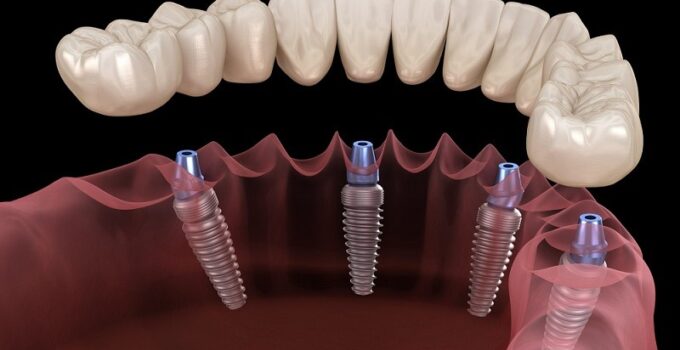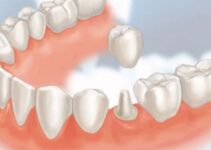Page Contents
Key Takeaways:
- 4 in 1 implants streamline the dental restoration process by combining four functions into a single device, reducing surgery time and discomfort.
- Advanced materials like titanium and zirconia enhance the strength, durability, and biocompatibility of implants.
- Immediate loading capabilities allow for same-day restoration, improving patient experience and reducing multiple visits.
- Cost-effectiveness arises from fewer appointments and reduced complications compared to traditional implants.
- 4 in 1 implants provide enhanced aesthetic and functional outcomes, optimizing oral health and improving patients’ confidence.
- The treatment process is condensed into a single visit, benefiting busy individuals and minimizing disruptions to daily life.
- Initial consultations ensure proper patient evaluation and set a positive tone for treatment discussions.
- Post-operative care is crucial for successful osseointegration and long-term implant functionality.
- Future trends in implant dentistry will heavily rely on technology, including AI, VR, and innovative materials for better outcomes.
- The healthcare environment is shifting towards more patient-centric designs, reducing invasiveness and prioritizing patient experiences.
The Magic of 4 in 1 Implants: Transforming Dental Care
What Are 4 in 1 Implants?
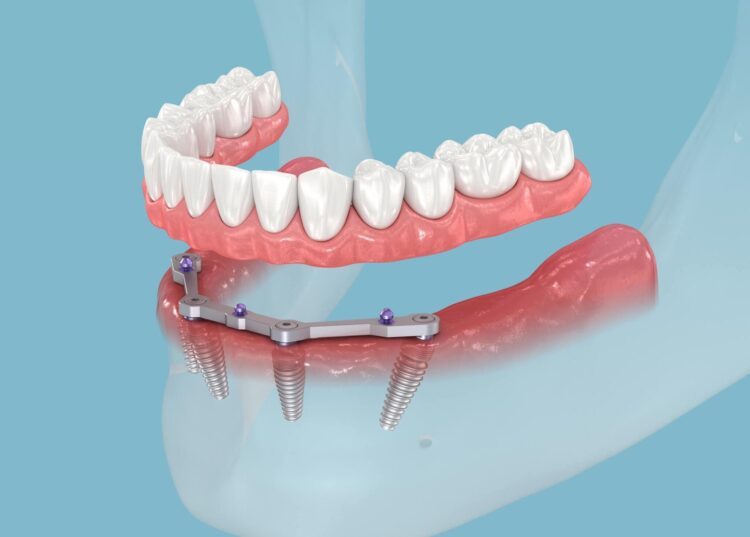
Source: valleycreekdentalcare.com
4 in 1 implants are a cutting-edge innovation in the field of dental prosthetics, representing a significant leap forward in how dental restoration can be approached. Unlike traditional implants, which typically involve a multi-step process including installing individual components for the root, abutment, and crown, 4 in 1 implants streamline these steps into one cohesive system.
Essentially, they integrate four crucial functions—implantation, abutment connection, immediate loading, and aesthetic confection—into a single device.
This holistic approach minimizes the surgery time, reduces post-operative discomfort, and accelerates the healing process for patients.
The core idea is to consolidate the functionalities typically spread over several appointments and procedures into one easy-to-manage implant system.
A Breakthrough in Dental Technology
The advancement of 4 in 1 implants signifies a breakthrough in dental technology that combines innovation in design with improved biomechanical principles. They utilize advanced materials, like titanium and zirconia, which not only enhance biocompatibility but also exhibit superior strength and durability, ensuring longevity and effectiveness.
Moreover, they are engineered using sophisticated CAD/CAM technology, allowing for precise fitting tailored to the patient’s anatomical needs.
This customizability ensures that each implant is optimally positioned to promote osseointegration—the process where the implant fuses with the bone—thereby maximizing both function and aesthetics.
Furthermore, advancements in 3D imaging and digital workflows facilitate the surgical planning process, ensuring that dentists can visualize the implant’s placement with unprecedented accuracy.
How 4 in 1 Implants Revolutionize Patient Experience
The introduction of 4 in 1 implants has revolutionized patient experience by making the entire dental implant process quicker, less painful, and more efficient.
Traditional dental implant procedures may involve multiple surgeries over months and prolonged healing times, which can often deter patients from pursuing necessary dental restorations.
With 4 in 1 implants, immediate loading is possible, meaning that patients can have their restoration placed on the same day as the surgery.
This not only significantly reduces the number of visits required but also allows patients to leave with a functional and aesthetically pleasing solution.
Additionally, the reduced need for invasive procedures lessens anxiety and fear associated with dental surgeries, making the experience far more tolerable for patients.
Unpacking the Benefits: Why Choose 4 in 1 Implants?
Cost-Effectiveness Compared to Traditional Options
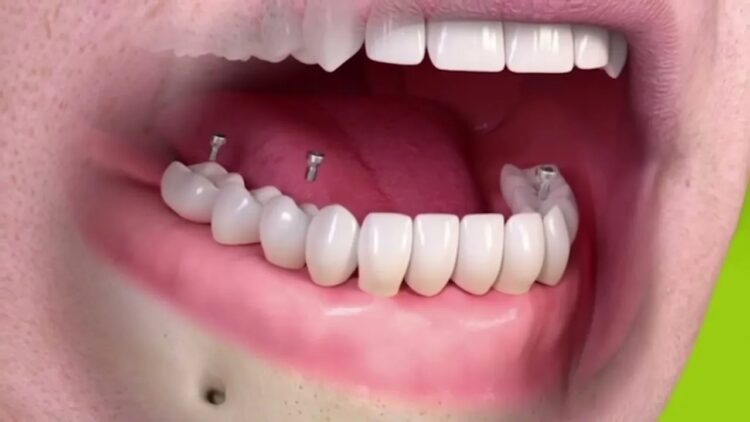
Source: allonfourimplantsfortlauderdale.com
The cost-effectiveness of 4 in 1 implants is a compelling argument for their adoption. While the initial investment may appear higher than traditional implants, when factoring in the decreased number of appointments, reduced surgical time, and the minimal need for follow-up care, the overall expense often turns out to be less.
Traditional implants may incur additional costs due to complications, potential follow-up procedures, or extended healing times that lead to lost productivity for patients.
Moreover, because 4 in 1 implants tend to have a higher success rate and lower complication rates, patients can often avoid the financial burdens associated with failed procedures or additional treatments.
This economic efficiency, combined with their longevity, positions 4 in 1 implants as a wise investment for not just immediate needs but long-term dental health.
Enhanced Aesthetic and Functional Outcomes
Another significant advantage of 4 in 1 implants lies in their ability to provide superior aesthetic and functional outcomes compared to traditional dental implants.
With their precise fit and immediate loading capabilities, these implants allow for better placement and alignment, which translates to enhanced functionality in chewing and speaking and a more natural appearance.
Because they can be placed where they are most effective, the overall functionality of the dental arch can be optimized, leading to improved oral health.
Furthermore, advancements in the aesthetics of dental crowns used with 4 in 1 implants allow for more lifelike restoration that mimics the color, shape, and translucency of natural teeth, significantly improving the patient’s smile and boosting their confidence.
The Time-Saving Advantage: Fewer Appointments
The protocol surrounding dental procedures can often become a burden, requiring patients to manage numerous appointments and prolonged treatments. 4 in 1 implants reduce this inconvenience substantially.
Patients can expect a comprehensive, efficient treatment process, often condensed into a single visit. This time-saving advantage is particularly beneficial for busy individuals who have hectic schedules and may struggle to find time for multiple dental appointments.
It also minimizes the disruption to daily life and allows patients to return to their normal activities much sooner.
The seamless integration from consultation to prosthetic delivery symbolizes a pivotal shift towards a more patient-centered approach in dentistry, where patient time and comfort are prioritized.
The Initial Consultation: What to Expect

Source: willisdentalcare.com
The initial consultation is a crucial step in the journey to receiving 4 in 1 implants, and it serves as the foundation for successful treatment. During this visit, the dental practitioner evaluates the patient’s oral health, discusses medical history, and determines eligibility for implants.
Digital imaging techniques, such as 3D scans, are often employed to provide a detailed view of the jawbone structure, allowing for precise treatment planning.
Patients should expect a comprehensive discussion about the procedure, including potential risks, benefits, and expected outcomes.
Furthermore, this is an opportunity for patients to ask questions and express their concerns, ensuring they are well-informed and comfortable with their impending treatment.
The initial consultation sets the tone for the entire process, fostering a trusting and transparent relationship between the dentist and patient.
Step-by-Step Guide to the Implant Procedure
The step-by-step process of receiving 4 in 1 implants is designed to be as efficient and straightforward as possible. Initially, local anesthesia is administered to ensure the patient remains comfortable throughout the procedure.
Following this, the dentist makes a small incision in the gum tissue to expose the bone where the implant will be placed.
Using advanced guided surgery techniques, the implant is precisely positioned into the jawbone. One of the key features of 4 in 1 implants is the immediate loading capability, meaning that a temporary crown is affixed to the implant during the same appointment, allowing for immediate function.
After the insertion, the dentist will prioritize the patient’s comfort, providing post-operative instructions to aid healing and promote optimal integration of the implant with the surrounding bone.
Post-Operative Care: Ensuring Long-Term Success
Post-operative care is essential for the long-term success of dental implants. Patients are often provided with detailed care instructions that may include guidelines on dietary restrictions, pain management, and good oral hygiene practices. It’s common for patients to experience some swelling and discomfort following surgery, but following the recommended care plan significantly enhances recovery.
Regular follow-up appointments facilitate monitoring of the healing process and success of osseointegration.
Additionally, patients need to maintain routine dental check-ups and adhere to a diligent oral hygiene regimen at home.
By prioritizing proper care, patients can enjoy the benefits of 4 in 1 implants for years to come, as they are designed to be a long-lasting, functional solution for tooth replacement.
Future Trends: Where Are Dental Implants Headed?
The Impact of Technology on Implant Dentistry
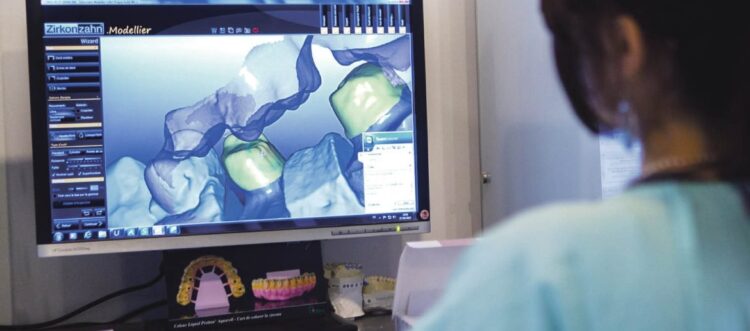
Source: smarttek.solutions
The future of dental implants is undeniably tied to advancements in technology. As the field of implant dentistry evolves, the integration of artificial intelligence and machine learning into treatment planning is anticipated to revolutionize how dental professionals approach diagnostics and surgical execution.
Automation in imaging and analysis will likely provide more insightful data that can translate into enhanced surgical outcomes and tailored treatment protocols for individual patients.
Augmented reality (AR) and virtual reality (VR) are also being explored for educational purposes and real-time surgical navigation.
These technological strides will not only refine the implantation process but will also elevate the overall experience for patients, making procedures quicker and more efficient while simultaneously improving safety and accuracy.
Exploring Innovations in Implant Materials
Another area of groundbreaking development is the exploration of new materials for dental implants. Traditionally, titanium has been the material of choice due to its strength and biocompatibility; however, the industry is witnessing a trend towards innovative materials, such as bioactive glasses and ceramics, that may offer enhanced properties.
These materials are designed to promote faster healing, greater osseointegration, and improved aesthetic results.
Moreover, research continues into surface modifications and coatings for implants that can encourage better integration with bone and soft tissues, ultimately improving long-term outcomes. As materials science evolves, patients can look forward to implants that not only meet but exceed current standards of care.
How Patient-Centric Design Shapes the Future of Dental Care
Finally, the future of dental care is becoming increasingly patient-centric, fostering a healthcare environment where the needs and experiences of patients are prioritized. The design of 4 in 1 implants is a direct reflection of this trend, aiming to reduce the invasiveness of dental procedures while maximizing outcomes.
Emphasis on comfort, minimize pain, and efficient recovery times are becoming essential elements in dental implant design and procedure formulation.
As feedback from patients becomes more integral to shaping future treatments, the industry is expected to see a rise in tailored solutions that resonate with the individual experiences of patients, ultimately leading to a healthcare landscape that is more responsive, accessible, and aligned with patient expectations.

